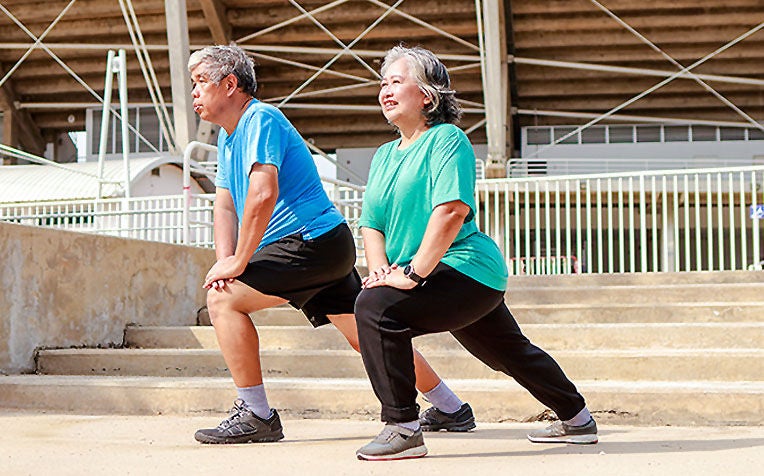
Doing some exercise before each meal makes it easier to hit the recommended amount of exercise per week.
A sedentary lifestyle and poor diet are key contributors to age-related loss in muscle mass, strength and function, also known as sarcopenia. This in turn increases the risk of falls in seniors.
Every year in Singapore, 1 in 5 older adults (aged 65 years and older) experiences a fall, resulting in injury and disability.
Why exercising first then eating after is beneficial
To tackle this problem of insufficient exercise and a lack of protein in diet, Dr Ng Lee Beng, Senior Consultant from the Department of Family Medicine Continuing Care at Singapore General Hospital (SGH), a member of the SingHealth group, shares a useful habit to cultivate:
|
Daily recommended amount of protein
How much protein a person should consume daily is dependent on age.
Health Promotion Board (HPB) recommends:
For younger adults under 50 years of age, aim for 60g of protein daily (about 20g per meal)
For older adults aged 50 years and over, aim for 75g of protein daily (about 25g per meal).
Dr Ng adds, “Muscle synthesis is higher when you spread protein intake evenly among three or more meals, rather than having most of it in a single meal. This optimises amino acid levels in the blood and promotes muscle repair and growth."
Ways to include protein in your day
When consuming protein, choose from high-quality sources.
For
1 serving of protein, which is equivalent to 20-30g of protein, you can include either of these food items in your meal:
Small bowl of edamame (200g) |
|
|
1 palm-sized piece of meat, fish or poultry (90g) |
|
|
|
|
|
|
Table courtesy of
Health Hub.
When cooking meals at home
For meals prepared at home, here are examples of how to add protein.

When eating out
When eating out, here are ways to incorporate protein for each meal.

When having a snack
If you are unable to meet the daily recommended amount of protein from your main meals, you can supplement with high-protein snacks between meals.
|  1 bowl of bean curd (unsweetened) ≅ 4g of protein | 
1 cup of soya milk (unsweetened) ≅ 7g of protein |
 1 slice of
whole grain bread
≅ 4g of protein |  1 cup of guava (unsweetened)
≅ 4.2g of protein |  1 cup of non-fat yogurt
≅ 8g of protein |
≅ means approximately equals to
Is animal protein better than plant protein or vice versa?
This is a question that Dr Ng frequently gets from her patients. Animal protein may contain a greater amount and more complete set of essential amino acids for muscle formation; however it usually comes packaged with saturated fat and cholesterol.
"Different plant proteins contain varying amounts and types of amino acids, including the essential ones. Hence previously it was thought that for protein synthesis, one must eat plant proteins in certain combinations at the same meal, for example, combining rice with legumes in order to ensure that one has taken the complete set of amino acids needed for protein synthesis," Dr Ng said.
"However, this has been debunked. It is now known that the human body can store the different amino acids. If one eats a variety of plant proteins regularly to replenish these stores, all the amino acids are available for protein synthesis at any time. There is no need to eat food in certain combinations in any one meal," she added.
Of the amino acids, the one in shortest supply in a plant-based diet is lysine. It is beneficial therefore to recommend taking more of the lysine-rich plant proteins. These also happen to be the ones we are most commonly recommending already, such as soy-based products (tofu, edamame, tempeh, soy milk), legumes (like beans, lentils, dried peas, peanuts), nuts and seeds (almonds, pistachios, walnuts, pumpkin).
Plant proteins also come packaged with other beneficial components such as fibre, antioxidants, minerals, vitamins, phytochemicals and water.
Thus, taking plant-based proteins reduces blood vessel inflammation, oxidative stress, heart disease and cancer risk and improves body's insulin sensitivity and ability to handle sugar.
Examples of grains, nuts and seeds, and legumes include:
Grains Nuts and Seeds | Legumes |
As you can see, there clearly are benefits to making time to squeeze in some exercise before each meal. But equally important of cultivating the habit of doing regular exercise, is the importance of proper nutrition during meals – which includes having a portion of protein for each meal to maintain muscle mass.
Ref: G25
Check out more articles on exercise tips:
Top Exercises for a Healthy Heart
Exercises to Lower Bad Cholesterol (LDL), Blood Pressure, Blood Sugar and Beat Obesity





















 Get it on Google Play
Get it on Google Play